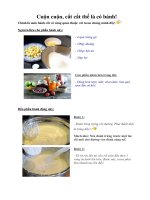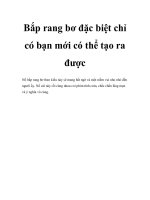THE VILPPU DRAWING MANUAL docx
Bạn đang xem bản rút gọn của tài liệu. Xem và tải ngay bản đầy đủ của tài liệu tại đây (2.12 MB, 12 trang )
The VILPPU
DRAWING MANUAL
BASIC FIGURE
DRAWING
7
he action of the figure is
usually expressed as
“gesture”. It means the
movement and attitude of the
figure. It is body language and
all of those subtle differences
that characterize individuals, be
they human or animal. In this
regard, when I refer to the
model, I mean not only a model
posing for short poses of thirty
seconds to three minutes, but
also people who are not posing,
and are in real life situations.
We use essentially the same
learning procedure in what is
referred to as the “quick
sketch”. It will be assumed
that, for the sake of learning, at
this point they are the same.
The primary difference between
this lesson and a regular class in
quick sketch is that we are only
applying the beginning steps of
the learning process for this
particular technique. Later in
this course, the gesture is
combined with other visual
learning tools to develop
drawings of longer duration
with different ends in mind.
The quick sketch uses some of
these tools, but its purpose is
quite different.
“Gesture is the single
most important
element in the
drawing.”
Other terms used for what we
call gesture are “attitude” and
“body language”. Gesture is
the single most important
element in the drawing. No
matter how well a drawing is
rendered, without that feeling
of individuality that we
experience in looking at real
life, the drawing is nothing
more than an academic
exercise. Long before we can
actually see a person’s face, we
can recognize him by all those
elements that make up that
individual, such as his general
bearing, proportions of his
body, how he dresses, how he
walks, and how he holds his
head.
I am going to present this
material in a series of steps,
stopping to explain and clarify
points as I go. In reality, of
course, it is never quite that
neat or simple. Many of the
T
Gesture
1
The Vilppu DRAWING MANUAL
8
BASIC FIGURE DRAWING
steps are actually done
simultaneously. The total is a
summation of the action in
simple terms and is essentially
what this lesson is about. The
illustrations are examples of
this total, which is what you
should, in a sense, see before
you start the drawing.
“You are not only
learning to draw, but
to see.”
Practice looking at your
subject, and then draw it from
memory. When doing gesture
sketches, you do not usually
have the luxury of models
holding still while you draw.
Practice this skill continually
wherever you happen to be -
on the bus, watching the
television, or in the shopping
mall. In looking at the action,
or gesture, it is important to
try to grasp the total before
you put a line down. Practice
looking at your subject and
then drawing it from memory.
This exercise is particularly
useful when you don't have
your sketchbook with you
(which shouldn't happen), or
are in situations where it is
awkward for one reason or
another to be drawing. When
drawing in your head, go
through the same steps and
use the same imaginary lines
you would if you were drawing
on paper. You draw with your
mind, not your hand. Then,
when you can, redo the
drawing on paper. With
practice, you will be amazed at
what you can do, but it takes
practice.
The Basic Procedure
You should do each drawing
using the same series of steps
until it becomes second nature
to you in a similar sense as how
driving a car becomes almost
automatic. Start the drawing
with simple lines that take in
the total action of the figure,
without worrying about the
shape. A simple sequence of
steps is indicated in the
following examples.
Remember, there are no rules,
just tools!
Step One
Start with a simple oval for the
head, imagining a central axis
so that the oval clearly
represents the tilt and lean of
your subject. Use a simple dot
on the top to indicate when the
head is tilting toward you, and
possibly an ellipse for the eyes
to help show more clearly the
action of the head.
“Gesture is the single
most important
element in the
drawing.”
The Vilppu DRAWING MANUAL
BASIC FIGURE DRAWING
9
Step Two
Draw a line from the head,
representing the neck. This line
is not necessarily any actual
contour or line that you see on
the model, but a general feeling
of the attitude of the model.
Continue this line, representing
the neck, pulling from the head
into the upper body and down
to the hips. You should be
more concerned with how the
lines show the action of the
model, rather than any actual
line that you see on the model.
Look at the examples on this
page to see the variety of ways
that this can be accomplished.
These are not the traditional
stick figures that you see in
many basic books on drawing.
They are the lines that show the
flow of the movement and
relationship of the parts in a
simple way.
Step Three
Continue in the same way,
drawing the legs. Notice that
all of the lines do not have to
be connected. Remember,
“there are no rules, just tools”.
It is important to remember the
simple fact that what the viewer
sees are the lines you put down
on the paper. The lines have to
convey the sense of action in
your subject by themselves. To
give a sense of movement and
continuity, you must draw each
line in such a way as to have
one line lead you into the next.
The Vilppu DRAWING MANUAL
10
BASIC FIGURE DRAWING
Step Four
Now add the arms and hands in
the same manner that we drew
the legs. Again, they do not
necessarily have to be attached,
but must indicate the
movement and general
placement.
In practice, these steps should
take you a maximum of thirty
seconds, with ten to fifteen
seconds being the average.
You should practice these
simple steps as often as you
can. In a regular day class, I
will have the students doing
this lesson for six hours.
Continue this simple first step
in feeling the form, then go a
step further and start pushing
outward with your lines. “Feel”
how forms contract and
stretch, pinch and expand.
Look at the sample drawings.
The Vilppu DRAWING MANUAL
BASIC FIGURE DRAWING
11
The hardest part of this lesson
is to overcome the desire to
copy the model. Remember,
we never copy the model, but
analyze it.
“Never copy the
model, analyze it.”
The Vilppu DRAWING MANUAL
12
BASIC FIGURE DRAWING
In these illustrations, I have
drawn arrows around the
figures to try to indicate the
directions I observed in the
pinches and stretches of the
form as I felt it.
Try to feel as if you were in the
pose, or take the pose yourself.
Try to feel where forms stretch
or bulge, which leg has the
weight on it, and in general,
become more aware of the
action.
Imagine an accordion. As one side compresses,
the other side stretches.
The Vilppu DRAWING MANUAL
BASIC FIGURE DRAWING
13
It is important to note that even
though I have presented this
material as a definite formula, the
end result is not a drawing that
appears mechanical. By focusing
on the action, the viewer will see
action.
The Vilppu DRAWING MANUAL
14
BASIC FIGURE DRAWING
The Vilppu DRAWING MANUAL
BASIC FIGURE DRAWING
15
The Vilppu DRAWING MANUAL
16
BASIC FIGURE DRAWING
The Vilppu DRAWING MANUAL
BASIC FIGURE DRAWING
17
The Vilppu DRAWING MANUAL
18
BASIC FIGURE DRAWING









